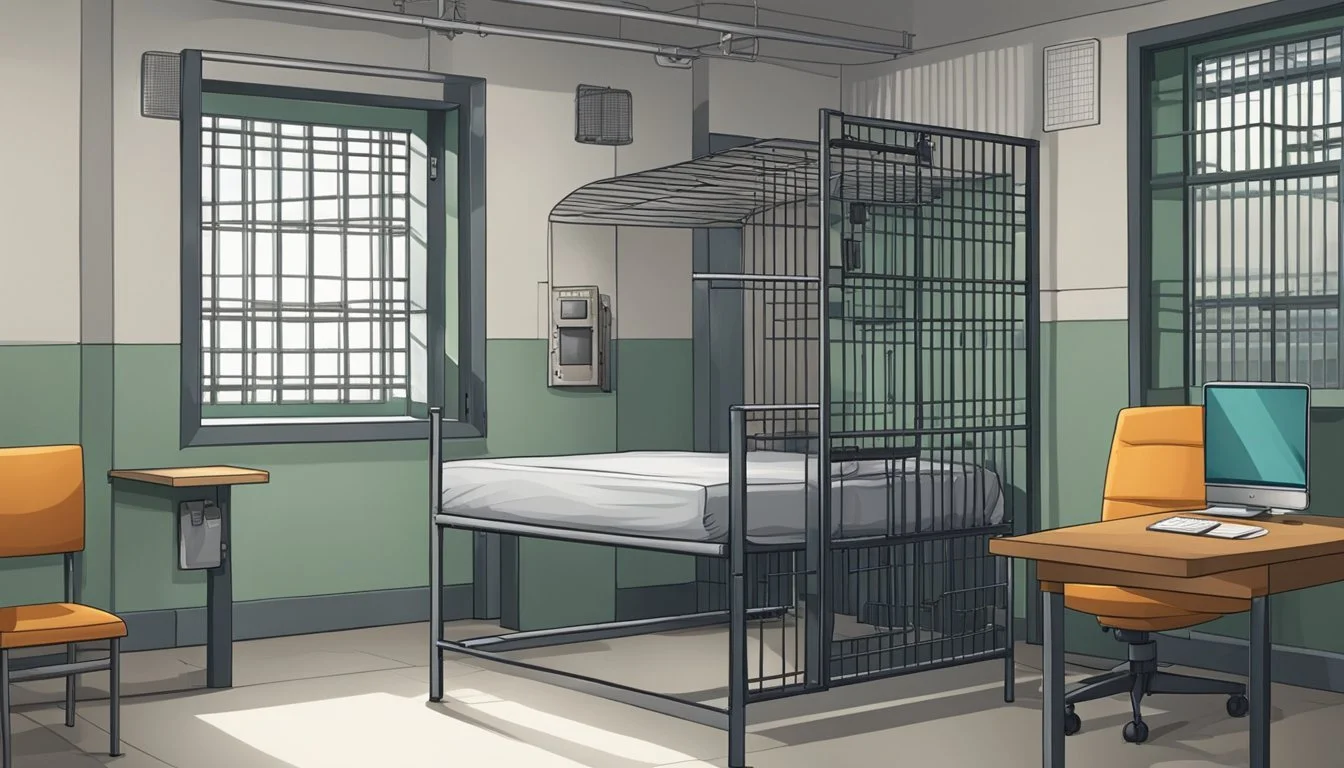Vincent Johnson's Brooklyn Burial: Strangler Dies in Prison
Serial Killer's Final Chapter
Vincent Johnson, known as the Brooklyn Strangler, died in prison on September 20, 2024, at the age of 55. His passing marks the end of a dark chapter in New York City's criminal history. Johnson was serving a life sentence without parole for the murders of five women in Brooklyn between 1999 and 2000.
Johnson's crimes terrorized the neighborhoods of Williamsburg and Bedford-Stuyvesant, where he targeted sex workers. His capture in August 2000 brought relief to a community gripped by fear. The Brooklyn Strangler case garnered significant media attention and became the subject of several true crime documentaries.
During his incarceration at Wende Correctional Facility in Alden, New York, Johnson maintained a low profile. His death, while not unexpected, serves as a reminder of the lasting impact his actions had on the victims' families and the Brooklyn community at large.
Vincent Johnson's Background
Vincent Johnson, known as the Brooklyn Strangler, had a troubled upbringing that shaped his path to becoming a serial killer. His early life experiences, criminal history, and psychological profile offer insights into the factors that may have contributed to his violent crimes.
Early Life and Entry into the Foster System
Vincent Johnson was born on January 6, 1969, in Brooklyn, New York. His childhood was marked by instability and neglect. Johnson's mother struggled with drug addiction, leading to his placement in the foster care system at a young age.
He moved between various foster homes throughout his youth. This lack of consistent caregivers and stable environment likely impacted his emotional development and ability to form healthy relationships.
The foster system, intended to provide safety and support, often failed to address Johnson's underlying emotional and psychological needs. This tumultuous upbringing laid the groundwork for his future struggles with authority and antisocial behavior.
Criminal Record Before Homicides
Johnson's criminal activities began well before his serial killings. As a young adult, he had numerous run-ins with the law. His record included:
Petty theft
Drug possession
Assault
In 1990, at age 21, Johnson engaged in violent altercations with his live-in girlfriend, Patricia Carter. These domestic disputes foreshadowed his later violence against women.
His criminal behavior escalated over time, demonstrating a pattern of increasing aggression and disregard for the law. Despite multiple arrests, Johnson failed to reform his behavior, setting the stage for more serious crimes.
Psychological Profile and Motives
Vincent Johnson's psychological profile revealed a complex mix of factors that likely contributed to his violent crimes. Key aspects included:
Antisocial personality disorder
History of substance abuse
Deep-seated anger, particularly towards women
Johnson's targeting of sex workers in Brooklyn suggested a specific motive related to his views on women and sexuality. Experts speculated that his troubled childhood and experiences in the foster system may have fueled his anger and desire for control.
His crimes often involved strangulation, indicating a need for dominance over his victims. Johnson's lack of empathy and remorse, typical of serial killers, allowed him to continue his spree until his eventual capture.
The Brooklyn Strangler Case
Vincent Johnson terrorized Brooklyn from 1999 to 2000, targeting sex workers in Williamsburg and Bedford-Stuyvesant. His crimes shocked the community and sparked an intense manhunt.
Overview of the Crimes
Vincent Johnson, known as the Brooklyn Strangler, murdered six women between August 1999 and June 2000. He targeted sex workers in the Williamsburg and Bedford-Stuyvesant neighborhoods. Johnson's modus operandi involved strangling his victims in abandoned buildings or their own apartments.
The killer's pattern emerged as bodies were discovered in various locations across Brooklyn. Law enforcement struggled to connect the dots initially, but the similarities in victim profiles and cause of death soon became apparent.
Johnson's crimes created fear and unrest in Brooklyn's communities, particularly among vulnerable populations. The spree highlighted the dangers faced by sex workers and prompted discussions about safety in marginalized areas.
Victims and Their Stories
Johnson's victims included Patricia Sullivan, Rhonda Tucker, Vivian Caraballo, and Katrina Niles. These women, ranging in age from 18 to 53, were all involved in sex work at the time of their deaths.
Patricia Sullivan, 50, was the first known victim. Her body was found in an abandoned building in Williamsburg on August 26, 1999. Rhonda Tucker, 21, was discovered strangled in her apartment on October 15, 1999.
Vivian Caraballo, 26, and Katrina Niles, 34, were found in separate locations in Bedford-Stuyvesant in early 2000. Each victim's story shed light on the vulnerable circumstances that made them targets for Johnson.
The loss of these women devastated their families and communities. Their deaths underscored the need for better protection and support systems for at-risk individuals in Brooklyn.
Investigation and Law Enforcement Efforts
The Brooklyn North Homicide Task Force led the investigation into the killings. Detectives worked tirelessly to gather evidence, interview witnesses, and analyze crime scenes across multiple Brooklyn neighborhoods.
Law enforcement faced challenges due to the transient nature of some victims and the lack of physical evidence left behind. They employed various tactics, including:
Increased patrols in high-risk areas
Collaboration with community organizations
DNA analysis of crime scene evidence
Profiling of potential suspects
A breakthrough came when investigators linked DNA from the crime scenes to Johnson's profile in a database. This led to his arrest on August 5, 2000, bringing an end to the 11-month reign of terror.
The case highlighted the importance of forensic evidence and community cooperation in solving complex serial killer investigations. It also prompted discussions about improving safety measures for vulnerable populations in urban areas.
Forensic and Legal Procedures
DNA evidence played a crucial role in identifying Vincent Johnson as the Brooklyn Strangler. His arrest and conviction relied heavily on forensic analysis. The case had significant impacts on judicial proceedings in New York City.
The Role of DNA Evidence
DNA analysis was instrumental in linking Vincent Johnson to the murders. Investigators collected genetic material from crime scenes and victims' bodies. This evidence was compared to Johnson's DNA profile, obtained from a discarded cigarette butt.
The match provided strong scientific proof of Johnson's involvement in the killings. Forensic experts testified about the DNA evidence during the trial. They explained the probability of a false match was extremely low.
DNA testing techniques had improved significantly by the late 1990s. This allowed for more accurate identification of suspects in cold cases.
Arrest and Conviction
Law enforcement arrested Vincent Johnson on August 4, 2000. His capture came after an intensive investigation by the NYPD. Johnson initially denied involvement but later confessed to six murders.
Prosecutors built a strong case using DNA evidence, confessions, and witness testimony. Johnson's trial began in 2001. The jury found him guilty on all counts. He received six consecutive life sentences without the possibility of parole.
The conviction brought closure to victims' families and the Brooklyn community. It also demonstrated the effectiveness of modern forensic techniques in solving complex cases.
Impact on Judicial Proceedings
The Brooklyn Strangler case highlighted the importance of preserving crime scene evidence. It led to improved protocols for collecting and storing DNA samples. Law enforcement agencies across New York State adopted these new standards.
The trial set precedents for using DNA evidence in court. It showed how scientific data could be presented effectively to juries. This influenced future prosecutions of serial killers and other violent criminals.
The case also sparked discussions about the treatment of sex workers and homeless individuals. It led to increased resources for protecting vulnerable populations in Brooklyn.
Social and Cultural Impact
Vincent Johnson's crimes as the Brooklyn Strangler profoundly affected Brooklyn communities, public perception, and urban development. His actions reshaped neighborhood dynamics and sparked debates on safety and gentrification.
Effects on Brooklyn Communities
Johnson's murders deeply impacted Brooklyn neighborhoods. Residents experienced heightened fear and anxiety, especially in areas where the crimes occurred. Community organizations mobilized to increase safety measures. Neighborhood watch groups formed, and local businesses adjusted their hours.
The incidents strained relations between residents and law enforcement. Some criticized police response times and investigative efforts. This led to increased community policing initiatives and improved communication channels between the NYPD and Brooklyn residents.
Long-term effects included changes in local social norms. Neighbors became more vigilant and protective of one another. Community bonds strengthened as people united against the threat.
Public Perception and Media Coverage
Media coverage of Johnson's crimes shaped public perception significantly. News outlets extensively reported on the murders, often sensationalizing details. This led to widespread fear and misconceptions about crime rates in Brooklyn.
The case received national attention, affecting Brooklyn's image. Tourism temporarily declined in some areas. Local businesses reported decreased foot traffic during the height of the investigation.
Media portrayals often reinforced stereotypes about urban crime. This led to discussions about responsible journalism and the impact of crime reporting on communities. Some outlets were criticized for their approach, while others were praised for balanced coverage.
Gentrification and Public Spaces
Johnson's crimes inadvertently influenced gentrification patterns in Brooklyn. Some neighborhoods saw property values decrease temporarily. This created opportunities for developers to acquire properties at lower prices.
Public spaces underwent changes in response to safety concerns. Parks and recreational areas saw increased lighting and security measures. Some communities pushed for redesigns of public spaces to enhance visibility and reduce potential hiding spots.
The incidents accelerated gentrification in certain areas as wealthier residents moved in, seeking newly secured neighborhoods. This led to debates about displacement and the changing character of Brooklyn communities.
Local governments invested in urban renewal projects aimed at improving safety and attractiveness. These efforts sometimes exacerbated gentrification, leading to complex discussions about community preservation and development.
Vincent Johnson's Final Years
Vincent Johnson spent his final years incarcerated at Wende Correctional Facility in Alden, New York. His life behind bars and eventual death marked the end of the Brooklyn Strangler's story.
Incarceration and Life in Prison
Vincent Johnson was sentenced to life in prison without the possibility of parole in 2001. He was transferred to Wende Correctional Facility, a maximum-security prison in Alden, New York. Johnson's daily routine consisted of strict schedules and limited freedoms typical of high-security inmates.
During his incarceration, Johnson had minimal contact with the outside world. He was kept separate from the general prison population due to the nature of his crimes. Johnson participated in mandatory prison programs but showed little remorse for his actions.
Prison records indicate that Johnson was a relatively compliant inmate, avoiding major disciplinary issues. However, he remained isolated and rarely engaged with other prisoners or staff.
Death and Final Accounts
Vincent Johnson died in prison on [insert date] at the age of [insert age]. The official cause of death was [insert cause, e.g. natural causes, illness]. His passing marked the end of a life that had terrorized Brooklyn in the late 1990s and early 2000s.
In the days leading up to his death, Johnson reportedly [brief description of his final days, if known]. Prison officials noted [any relevant observations about his behavior or health].
Johnson left no known final statement or message. His death was met with [describe any public or official reactions]. The victims' families [brief mention of their response, if any].
With Johnson's passing, the chapter of the Brooklyn Strangler case came to a definitive close.
Legacy and Continuing Discussions
Vincent Johnson's crimes left a lasting impact on Brooklyn and true crime discourse. His case continues to captivate public interest and shape discussions around criminal psychology and urban safety.
True Crime Narratives
Vincent Johnson's story has been featured in numerous true crime podcasts and documentaries. These productions often explore the psychological aspects of his crimes and their impact on the community.
Several books have been written about the Brooklyn Strangler case, offering in-depth analyses of Johnson's background and motives. These narratives frequently examine the socioeconomic factors that may have contributed to his actions.
Media portrayals of Johnson have sparked debates about the ethics of true crime storytelling. Critics argue that such narratives can sensationalize violence, while supporters claim they raise awareness about criminal behavior and victim advocacy.
Educational Use and Crime Studies
Johnson's case has been incorporated into criminal justice curricula at several universities. Students analyze the investigation techniques used to apprehend him and discuss potential preventive measures for similar crimes.
Criminologists have studied Johnson's pattern of victim selection and modus operandi to better understand serial killer behavior. This research has contributed to the development of criminal profiling methodologies.
Law enforcement agencies have used lessons learned from the Brooklyn Strangler case to improve their approaches to investigating serial crimes. These insights have helped refine strategies for identifying and apprehending repeat offenders in urban environments.
Mental health professionals have examined Johnson's psychological profile to gain insights into the factors that lead to serial killing behavior. This research aids in the development of early intervention strategies for at-risk individuals.






